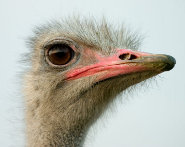Ostrich
The Ostrich, Struthio camelus, is a large flightless bird native to Africa. It is the only living species of its family, Struthionidae and its genus, Struthio. Ostriches share the order Struthioniformes with the kiwis, Emus, and other ratites. It is distinctive in its appearance, with a long neck and legs and the ability to run at maximum speeds of about 70 km/h , the top land speed of any bird. The Ostrich is the largest living species of bird and lays the largest egg of any living bird .

The Ostrich - The Largest Bird in the World
 The Ostrich (Struthio Camelus), which lives in Africa, is the largest and heaviest bird in the world. This flightless bird stands between 7 to 9 feet, which is equivalent to 2.1 to 2.7 meters, and weighs between 198 to 287 pounds, or about 90 to 130 kilograms. Full-grown male ostriches are usually larger than females.
The Ostrich (Struthio Camelus), which lives in Africa, is the largest and heaviest bird in the world. This flightless bird stands between 7 to 9 feet, which is equivalent to 2.1 to 2.7 meters, and weighs between 198 to 287 pounds, or about 90 to 130 kilograms. Full-grown male ostriches are usually larger than females.
This bird has extremely strong, powerful legs that allow them to run up to 43 miles an hour in short bursts, which is approximately 70 kilometers an hour. This bird has a huge stride, which measures between 10 to 16 feet, or about 3 to 5 meters. The ostrich's legs are so strong that they can kill an animal as large as a lion or a human with a single kick.
Although the ostrich does not use its wings for flying, they do use them as rudders while running, tipping and turning them to help them balance as they move. They also use their wings, as well as their tail feathers, in elaborate courtship dances, fanning them and showing off to each other in a dramatic, flashy show. After mating, an ostrich hen will lay between five to eleven eggs.
The ostrich is a very attractive bird. The males are a dramatic black and white, while the females tend to be gray or brown and white. Both sexes have long bare necks and legs small heads. Unlike other birds whose feathers lay smoothly and tightly together, the ostrich's feathers are loose and give the bird a somewhat shaggy appearance.
Ostriches can be found in open savannas and deserts throughout much of central and southern Africa. This bird is an herbivore that eats mostly grasses, seeds, roots and leaves, although it will also eat insects, small lizards, as well as the occasional invertebrate. Ostriches get most of their water from the vegetation they eat and so do not need to drink water very often. Because these large birds don't have teeth, they must also ingest small stones and sand to help them digest their food.
The ostrich is preyed upon by many of the large predators in Africa, including cheetahs, African wild dogs, lions and hyenas. Its babies are particularly vulnerable to predators and only 15 percent typically make it to adulthood. However, ostriches are still widespread and common and are listed as a species of least concern on the IUCN's Red List of Threatened Species.
Picture of the ostrich by A. Kniesel, licensed under GFDL
The Ostrich is classified as Least Concern. Does not qualify for a more at risk category. Widespread and abundant taxa are included in this category.

Family : Struthionidae
Genus : Struthio
Species : camelus
Authority : Linnaeus, 1758
